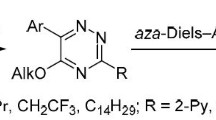Abstract
The synthesis and photophysical characterization of the phosphorylated Bodipy dye 5 are reported and compared to those of its hydroxyphenyl counterpart 1. Conversion of the latter by three methods of phosphorylation yields the strongly fluorescent dye 5 which exhibits similar steady-state spectra like 1 but an approximately five times prolonged fluorescence lifetime τFl. We attribute this distinct change from τFl = 0.7 ns for 1 to τFl = 3.7 ns for 5 to the suppression of photoinduced electron transfer in 5. This photochemical reaction was previously held responsible for fluorescence quenching in 1. Fluorescence correlation spectroscopy reveals that 5 can be detected by single-molecule methods and that uncaging of phosphate in 5 is a minor problem.






Similar content being viewed by others
References
Ziessel R, Ulrich G, Harriman A (2007) The chemistry of Bodipy: A new El Dorado for fluorescence tools. New J. Chem 31:496–501
Loudet A, Burgess K (2007) BODIPY dyes and their derivatives: Syntheses and spectroscopic properties. Chem Rev 107:4891–4932
Gabe Y, Urano Y, Kikuchi K, Kojima H, Nagano T (2004) Highly sensitive fluorescence probes for nitric oxide based on Boron dipyrromethene chromophore—rational design of potentially useful bioimaging fluorescence probe. J Am Chem Soc 126:3357–3367
Basaric N, Baruah M, Qin W, Metten B, Smet M, Dehaen W, Boens N (2005) Synthesis and spectroscopic characterisation of BODIPY based fluorescent off–on indicators with low affinity for calcium. Org Biomol Chem 3:2755–2761
Kollmannsberger M, Rurack K, Resch-Genger U, Daub J (1998) Ultrafast charge transfer in amino-substituted Boron dipyrromethene dyes and its inhibition by cation complexation: A new design concept for highly sensitive fluorescent probes. J Phys Chem A 102:10211–10220
Rurack K, Kollmannsberger M, Resch-Genger U, Daub J (2000) A selective and sensitive fluoroionophore for HgII, AgI and CuII with virtually decoupled fluorophore and receptor. J Am Chem Soc 122:968–969
Qi X, Jun E, Kim S, Hong J, Yoon Y, Yoon J (2006) New BODIPY derivatives as off–on fluorescent chemosensors and fluorescent chemodosimeter for Cu2+: cooperative selectivity enhancement toward Cu2+. J Org Chem 71:2881–2884
Li M, Wang H, Zhang X, Zhang H-S (2004) Development of a new fluorescent probe: 1,3,5,7-tetramethyl-8-(4′-aminophenyl)-4,4-difluoro-4-bora-3a,4a-diaza-s-indacene for the determination of trace nitrite. Spectrochim Acta A 60:987–993
Kalai T, Hideg K (2006) Synthesis of new, BODIPY-based sensors and labels. Tetrahedron 62:10352–10360
Koutaka H, Kosuge J, Fukasaku N, Hirano T, Kikuchi K, Urano Y, Kojima H, Nagano T (2004) A novel fluorescent probe for Zinc ion based on Boron dipyrromethene (BODIPY) chromophore. Chem Pharm Bull 52:700–703
Urano Y, Kamiya M, Kanda K, Ueno T, Hirose K, Nagano T (2005) Evolution of fluorescein as a platform for finely tunable fluorescence probe. J Am Chem Soc 127:4888–4894
Tietze L, Eicher T (1991) Reaktionen und Synthesen im organisch-chemischen Praktikum und Forschungslaboratorium. Thieme, Stuttgart
Silverberg L, Dillon J, Vemishetti P (1996) A simple, rapid and efficient protocol for the selective phosphorylation of phenols with dibenzylphosphite. Tetrahedron Lett 37:771–774
Kaboudin B (1999) Phosphorylation of phenols with diethylchlorophosphonate on the surface of magnesia. J Chem Res 402–403, DOI 10.1039/a900183b
Widengren J, Mets Ü, Rigler R (1995) Fluorescence correlation spectroscopy of triplet states in solution: A theoretical and experimental study. J Phys Chem 99:13368–13379
Coskun A, Deniz E, Akkaya E (2005) Effective PET and ICT switching of boradiazaindacene emission: A unimolecular, emission mode molecular half-subtractor with reconfigurable logic gates. Org Lett 7:5187–5189
Gareis T, Huber C, Wolfbeis O, Daub J (1996) Phenol/phenolate-dependent on/off switching of the luminescence of 4,4-difluoro-4-bora-3a,4a-diaza-s-indacenes. Chem Comm 1717–1718, DOI 10.1039/a703536e
Baruah M, Qin W, Basaric N, DeBorgraeve W, Boens N (2005) Bodipy-based hydroxyaryl derivatives as fluorescent pH-probes. J Org Chem 70:4152–4157
Lazar S, Guillaumet G (1992) A selective removal of benzyl protecting groups in arylphosphate esters with bromotrimethylsilane. Synth Comm 22:923–931
Klähn M, Mathias G, Kötting C, Nonella M, Schlitter J, Gerwert K, Tavan P (2004) IR spectra of phosphate ions in aqueous solution: Predictions of a DFT/MM approach compared with observations. J Phys Chem 108:6186–6194
Qin W, Baruah M, Stefan A, Van der Auweraer M, Boens N (2005) Photophysical properties of BODIPY-derived hydroxyaryl fluorescent pH probes in solution. ChemPhysChem 6:2343–2351
Goeldner M, Givens R (2005) Dynamic Studies in Biology. Wiley, Weinheim
Acknowledgement
Financial support is provided by the German Science Foundation (DFG, JU-650/2-2). We are indebted to Benjamin Hötzer, Babette Hinkeldey, Michael Schmitt and Rolf Hempelmann for assistance and support.
Author information
Authors and Affiliations
Corresponding author
Rights and permissions
About this article
Cite this article
Jacob, M., Schmitt, A. & Jung, G. Disabling Photoinduced Electron Transfer in 4,4-Difluoro-8(-4′-hydroxyphenyl)-1,3,5,7-tetramethyl-4-bora-3a,4a-diaza-s-indacene by Phosphorylation. J Fluoresc 18, 639–644 (2008). https://doi.org/10.1007/s10895-008-0373-7
Received:
Accepted:
Published:
Issue Date:
DOI: https://doi.org/10.1007/s10895-008-0373-7



